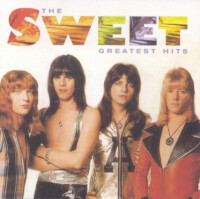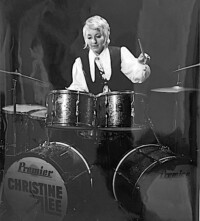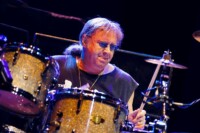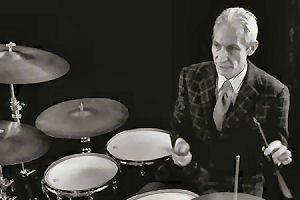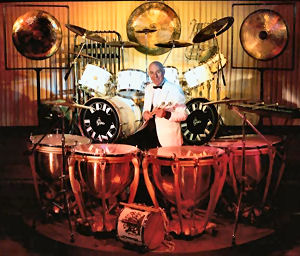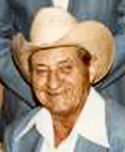 I’ve always had more than a passing interest in ‘Western Swing’ music, since in essence it was close to the ‘skiffle’ many of us ‘older’ Brits started our careers with. My curiosity was whetted further when I played with Don McLean who every now and then would throw in songs within the genre. And, over the years I’ve played gigs with ‘Asleep At The Wheel’ who specialise in an up-to-date version of the music.
I’ve always had more than a passing interest in ‘Western Swing’ music, since in essence it was close to the ‘skiffle’ many of us ‘older’ Brits started our careers with. My curiosity was whetted further when I played with Don McLean who every now and then would throw in songs within the genre. And, over the years I’ve played gigs with ‘Asleep At The Wheel’ who specialise in an up-to-date version of the music.
Bob Wills was a brilliant fiddle player and the leader of the very foremost of these bands who wanted to impart a more obvious beat to what was ostensibly called somewhat disparagingly, a ‘fiddle band’. The genre was particularly prevalent in the South West of America and in his heyday Bob Wills attracted thousands to the dancehalls he played in. In that huge area of America at the height of his success he would pack more people into these places than established jazz artists like Tommy Dorsey and Benny Goodman. But of course it wasn’t always like this and when he began Bob simply wanted his band to be more commercial and danceable and in the fullness of time be able to sell out the halls where he would be playing every night to thousands. This was obviously where the real money was to be found.
‘Smoky’ Dacus (also known to the internet as Smokey with an ‘e’) was born in Quinton, Oklahoma on July 24th 1911 and as the first drummer for Bob Wills and the Texas Playboys he really began this whole Western Swing thing. His father didn’t approve of music and like many others living in America’s Bible-belt actually regarded it as sinful. Nevertheless somehow he learned to play first the banjo, then the guitar and finally the drums. This prowess lead to him attending University in Tulsa and playing in the college’s orchestra, marching band and more significantly the ‘Eight Collegians’ which was a Dixieland dance band. This was where he learned his craft and Tulsa was where he saw Duke Ellington playing and of course his drummer caught his eye. The unmissable Sonny Greer had a profound influence on him and became an important friend.
There was no doubt the sort of music Smoky was into was Dixieland jazz. Not Hillbilly Jazz because that genus wouldn’t exist until he joined Bob Wills and together with the rest of band they would invent that particular style. In 1934, Smoky was working in a hotel orchestra in Tulsa and playing Dixieland Jazz with a reputation of being a young,’modern style musician’, when his path crossed with Bob Wills. Bob was certain that the insistent beat he was looking for would be provided by exactly the Dixieland ‘feels’ Smoky was playing. He invited Smoky to join him but his lucrative offer was met with some scepticism because the Playboys were a fiddle band. What on earth would they want a drummer for? Bob Wills’ response was that he wanted to put Smoky’s kind of music together with his kind of music – and make it swing!
So Smoky Dacus threw in his lot with Bob Wills and his Texas Playboys at the very beginning of 1935 when he was coming up to 24. Together they would introduce this new insistent, drum-driven and irresistibly danceable Country Music to literally hundreds and thousands of music fans in the South Western USA and beyond. The music they played was said to have come about by blending Country and Western, Boogie Woogie, Blues and Jazz.
If Benny Goodman was indisputably the ‘King of Swing’ then Bob Wills became justifiably known as “The King of Western Swing”.
The story goes that in those dancehall days in America’s South West thousands of people gathered together in huge ballrooms specially built for dancing in an effort to forget their troubles and hopefully meet the opposite sex. Country music was what they were all listening to on their radios but you couldn’t really dance to it. The beat was never obvious or solid enough to persuade crowds of people to get out on the floor in a large hall and glide rhythmically and elegantly around it. (I have heard a possibly apocryphal story that dance hall owners would sprinkle chilli powder on the floor which the dancers would cause to rise with their feet which would persuade the distaff side of the pleasure seekers to dance even more vigorously.)
Prior to this, what pulse there was in the music was supplied by banjos and rhythm guitarists who muted their strings to provide a bit more percussive force to the music. There certainly weren’t any drummers in Country and Western music because firstly they simply weren’t deemed necessary, and secondly they were looked down on and actually banned in prestigious place like Nashville’s ‘Grand Ole Opry’. (That veto wasn’t rescinded until the seventies but some artists like Buddy Harman were allowed to bend the rules but if any artist did it without permission it was a pyrrhic victory because they weren’t invited back. (This may even have happened to Bob Wills.) Mostly when permission was grudgingly given to bring a drummer to ‘The Opry’ they had to play behind curtains!
To be honest Jimmie Rodgers (the singing Brakeman not the ‘Kisses Sweeter than Wine’ chap) had dabbled with drums on record at the very end of the twenties and a bandleader called Milton Brown sometimes added a drummer for dances but Bob Wills took the music to what appears to us now to be an obvious conclusion by adding a drummer to what was sometimes a 22 piece dance orchestra still with fiddles, slide guitar, horns and slick presentation and good-hearted humour. This is why with that abundance of people on the stage (with the drummer right at the back as usual) it’s difficult for me to say exactly what drums Smoky used. One of the sets on Youtube looks like a Leedy with ‘T-handled tensioners’ on the larger toms but it could just as easily be a Slingerland. There are also movies of what I’m guessing is a WFL behind Bob but since The Playboys had a lot of drummers who all wore Stetson hats it’s impossible to say for sure who’s playing and exactly when it was. It’s remarkable because whoever is playing the WMP set is using a small 20 (or 22) inch bass drum!
Bob Wills evidently hated the Hillbilly image of country music and wanted the Playboys’ stage uniforms to be like formally dressed cowboys. He himself looked like a well-dressed Texan politician – think a less portly Lyndon Johnson. That hayseed ‘Yee haw’ straw hat, corn cob pipe and dungarees style of dress was not for him at all. But looks weren’t the only thing he wanted in his band – you had to be both an exceedingly good musician and a good person.
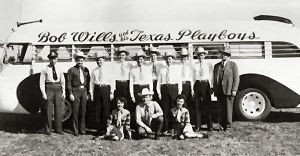 But was there anything different about the drumming Smoky Dacus was contributing to the emerging Western Swing music? The answer is not really. He was simply adding something which hadn’t been there before and it was deemed by Bob Wills to need it. The clue is in the second world of the title of course. Swing music implies ’the lilt’ which would certainly have been prevalent in the rudimental drumming he’d been playing in the college’s marching band and the ‘Collegians’. (Lilt is a device used in the ‘feels’ of Scottish pipe bands and French marching bands. The fast broken triplets of the French soldiers in New Orleans arguably gave rise to the rhythms of Dixieland jazz.) In short Smokey was no stranger to both of these drumming worlds and would have had no problem playing a mixture of them over the top of the rhythms of country music. Having listened to a great deal of Western Swing while writing this, I don’t believe Smoky’s role was simply to provide a kick to propel the dancers, more a stimulus for the rest of the musicians so that they would collectively drive the music and the dancers. His rhythms weren’t particularly complicated at all being mostly a relentless slightly ‘dotted’ version of 2/4. Otherwise Smokey Dacus was playing proper big band music with fills, accents and bomb drops. (I have seen some charts for Western Swing where the notation was simply two crochets in a bar although I’m not sure how successful this would turn out to be because, as Duke Ellington often said: “It don’t mean a thing if it ain’t got that swing.” Eventually Bob Wills’ drummers would be playing ’10 to 2, 10 to 2′ but it wasn’t until Buddy Harmon became the busiest drummer in Nashville that there would be an unbroken shuffle in country music which he played with a stick and a brush.
But was there anything different about the drumming Smoky Dacus was contributing to the emerging Western Swing music? The answer is not really. He was simply adding something which hadn’t been there before and it was deemed by Bob Wills to need it. The clue is in the second world of the title of course. Swing music implies ’the lilt’ which would certainly have been prevalent in the rudimental drumming he’d been playing in the college’s marching band and the ‘Collegians’. (Lilt is a device used in the ‘feels’ of Scottish pipe bands and French marching bands. The fast broken triplets of the French soldiers in New Orleans arguably gave rise to the rhythms of Dixieland jazz.) In short Smokey was no stranger to both of these drumming worlds and would have had no problem playing a mixture of them over the top of the rhythms of country music. Having listened to a great deal of Western Swing while writing this, I don’t believe Smoky’s role was simply to provide a kick to propel the dancers, more a stimulus for the rest of the musicians so that they would collectively drive the music and the dancers. His rhythms weren’t particularly complicated at all being mostly a relentless slightly ‘dotted’ version of 2/4. Otherwise Smokey Dacus was playing proper big band music with fills, accents and bomb drops. (I have seen some charts for Western Swing where the notation was simply two crochets in a bar although I’m not sure how successful this would turn out to be because, as Duke Ellington often said: “It don’t mean a thing if it ain’t got that swing.” Eventually Bob Wills’ drummers would be playing ’10 to 2, 10 to 2′ but it wasn’t until Buddy Harmon became the busiest drummer in Nashville that there would be an unbroken shuffle in country music which he played with a stick and a brush.
Now what to me is perhaps the most extraordinary thing about Smoky Dacus is this – just as he was making lots of money by playing to baying crowds of people almost every night around the South-West along with almost daily radio broadcasts from Tulsa, he decided to hang up his drum sticks. He had begun with Bob Wills in 1935 and stayed with him until 1941 but, believe it or not Smoky decided that being a musician was simply too precarious an occupation at the time and abruptly left the band. Just as the US entered WW2 he sold his drums and involved himself firstly with aviation, whereupon he became a mechanic and pilot in the oil industry. He stayed there for the rest of his working life although he did play drums on an album with Bob Wills, Merle Haggard and the surviving members of the Playboys in1973.
Smoky Dacus died in Rogers Arkansas on October 9th, 2001.
I have long felt that without Smoky’s involvement with Bob Wills, ‘Rock Around the Clock’ might never have happened. For those who don’t know, Billy Gussak was another big band drummer from virtually the same era who was brought in to play on Bill Haley and the Comets’ seminal record in 1954. It doesn’t demand a quantum leap to see what ‘Rock Around the Clock’ owed to Country Swing.
That said, even though he invented it Smoky Dacus was not the most famous drummer in Western Swing. Believe it or not Joe Morello played in the idiom along with celebrated jazz guitarist Hank Garland in the Arkansas Cotton Pickers in 1947.
As far as examples of his work are concerned Smoky Dacus played on classic recordings such as “Maiden’s Prayer,” “Sittin’ on top of the world”, “New San Antonio Rose” and “Steel Guitar Rag”. All of these and many more are on Youtube along with “Ida Red” which is an even more interesting tune when you know it gave rise to Chuck Berry’s ‘Maybelline’.
After Smoky left the band Bob Wills went to Hollywood and he was followed into the Playboys by several other Dixieland drummers including Monte Mountjoy and Johnny Cuvielo.
Charles Townsend was Bob Wills’ biographer who tells that:
“Dacus played an important role in western swing and country music history. This was the first time drums were successfully used in a string band. Dacus helped create the solid dance beat Wills was after, and his drumming moved the band further from traditional fiddle or string band music and even closer to jazz.”
Jean Boyd wrote even more glowingly about him in her book on Bob Wills: while debating the great swing rhythms of Count Basie, Jimmy Lunceford, Duke Ellington and Bob Wills she let slip that, in her opinion Smoky Dacus was among the great swing drummers of the era.
Bob Henrit
December 2013

